G.T. Mundorff, 1926 (Source: Woodling)
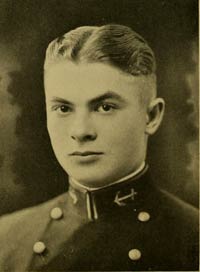 |
George Mundorff landed once at Tucson, Monday, August 19, 1929. He flew an unidentified Boeing F2B. Based at San Diego, CA aboard the U.S.S. Saratoga, he arrived amidst nineteen other naval aviators, each signed into the Register on the middle third of page 112. Other than the first six who signed their own names, the rest were entered by an unknown hand all at once. Please direct your browser to the link and review page 112. There you'll see that signers Chourre through Wick comprise the group of twenty. They all remained overnight at Tucson, departing the morning of the 20th for El Paso, TX.
Mundorff-Weir Wedding, The New York Times, February 13, 1927 (Source: NYT)
 |
What were twenty Navy pilots doing at Tucson all at once? They were on a grand cross-country flight headed from San Diego to Cleveland, OH and back to participate in the National Air Races (NAR) held August 24th-September 2nd at Cleveland that year. Lt. Cdr. Homer Wick was commanding officer of Squadron No. 1 based on the Saratoga.
Wick brought his entire squadron through Tucson on behalf of the NAR. During the 1920s and 1930s, the Navy ordered numerous activities by its personnel, ships and airplanes to build confidence in the naval force among the U.S. citizenry, to provide real-life training for personnel, as well as to encourage recruitment.
Mundorff's job in the group was participation with the aerobatic team named the "Nine Hight Hats." He also participated in event No. 21 of the NAR, the Navy Pursuit Race. It took place on August 30th and covered 100 miles in ten, 10-mile laps. According to the Aircraft Yearbook for 1930, sixteen navy pilots competed. He placed eighth with an average speed of 120.40MPH.
Mundorff had just graduated from the U.S. Naval Academy in 1926. Almost immediately he married Jeanne Mallison Weir. The article from The New York Times of February 13, 1927, above left, describes the ceremony.
Below, Mundorff, the still relatively new groom, is circled and shown with the rest of his section (the officer to his left, and kneeling in front) and the entire 9-man team just three days before he landed at Tucson. Please direct your browser to Wick's page to see a tabulation and identification of all the men in his squadron.
The "Nine High Hats," August 16, 1929 (Source: NHH via Bob Woodling)
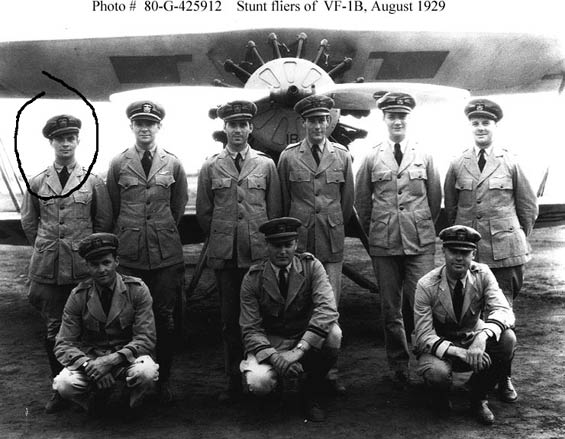 |
Below, from the Naval Academy yearbook, are two photographs and tongue-in-cheek description of Mundorff exhibiting some of the argot of the day. His academic prowess ("Ac Department") was recognized even then, and would serve him well in later life.
George T. Mundorff, U.S. Naval Academy Yearbook, 1926 (Source: Woodling)
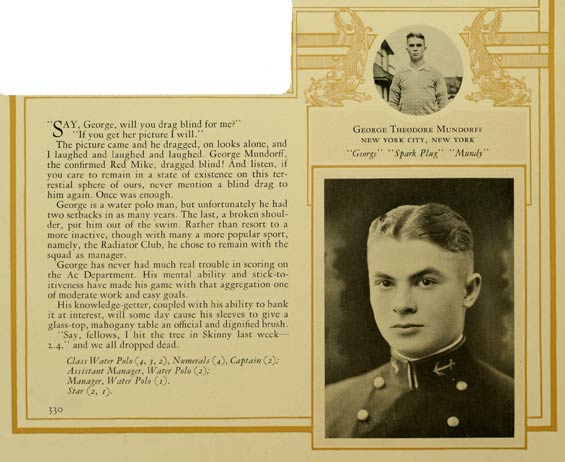 |
There is surprisingly little information online about Mundorff. I have no information about his Navy career during the 1920s and 30s or after WWII through to his retirement. A cousin provides a genealogical report that you may download (PDF, 28Kb). It delves briefly into his naval career, married life and children.
Preceding WWII, as a lieutenant commander, Mundorff took command of Patrol Squadron VP-21 in February, 1941, the third squadron to be assigned the VP-21 designation. In the weeks after the Japanese attack on Pearl Harbor, and just before his command, Mundorff was in the thick of things. Stationed at Midway Island, on December 17, 1941 he departed Midway at 6:18PM and arrived at Pearl Harbor at 7:05 PM escorting a commandeered Dutch PBY-5 that was severely damaged during the attack on Midway. On Friday, January 2, 1942 at 7:15PM he attacked a surfaced submarine 119 miles south of Oahu. The splash of the exploding depth charges broke on the deck but the results were uncertain.
Patent, Photographic Computer, August 8 1950 (Source: Web)
 |
On August 8, 1950, while still with the Navy, Mundorff filed and received a U.S. Patent for a "Computer for Flash and Flood Lamp Photography." The patent is available as a download at the link (4 pages, PDF 192kB). The device is a flat circular slide rule, as indicated in the figure, left, from his patent. It calculated shutter settings (f-stops) and exposure times, replacing cumbersome printed tables and hand calculations. The design was certainly familiar to Mundorff, and every other pilot before the advent of handheld calculators, as the "Whiz Wheel" used by pilots and navigators to calculate time-speed-distance solutions, true airspeed and wind correction angles.
Jax Air News, September 3, 1953 (Source: Web)
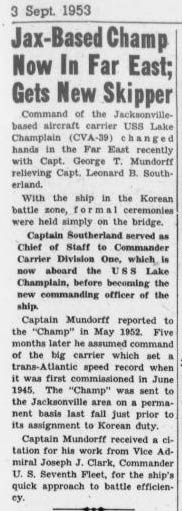 |
In 1952 the aircraft carrier U.S.S. Lake Champlain was recommissioned for Korea. Mundorff was assigned as commanding officer. Article, right, from the Jax Air News, September 3, 1953 describes what seems to be a hiatus in Mundorff's command, with a return to that responsibility once the the carrier was in the Korean battle zone. The Jax Air News is the internal publication for the Naval Air Station, Jacksonville, FL.
On its way east, sailing through the Suez Canal on May 14th, the Lake Champlain was the largest ship to-date to do so. At least one incident aboard the Lake Champlain involved Mundorff while they were in the Korean war zone. The article below from the Jax Air News of November 12, 1953 describes the action.
Jax Air News of November 12, 1953 (Source: Web)
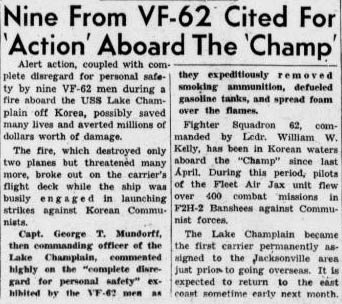 |
The Korean Armistice went into effect July 27, 1953 and Mundorff was reassigned. As an interesting side note, the Lake Champlain, on January 31, 1960, would retrieve the chimpanzee, "Ham," from the Atlantic 420 miles downrange from Cape Canaveral. The success of this flight and the recovery advanced the time line of the first U.S. manned space flight in the Mercury Freedom 7.
Librazette, August, 1961 (Source: Web)
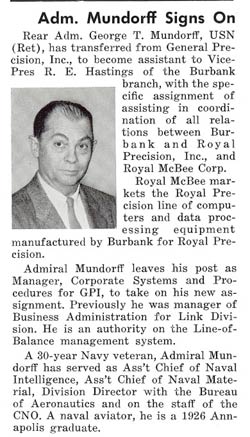 |
During the 1960s, Mundorff, having left the Navy, was employed by General Precision, Inc. (GPI) as Manager, Corporate Systems and Procedures in that growing computing industry. At left, an article from the General Precision internal publication, Librazette from August, 1961. The Librazette was published monthly by the Employee Relations department for the employees of the Librascope Division, General Precision, Inc., at 808 Western Ave., Glendale, CA.
Librascope Division focused on optical digital and analog military computing, such as airborne cameras and periscopes, data processors for central command and control, fire control computers for shipboard anti-aircraft guns, missile guidance, and other onboard computing devices for aircraft (bomb aiming, cargo loading, etc.).
More broadly, GPI produced computers for commercial and engineering use, as well as peripherals, such as magnetic disc memory systems. An advertising brochure for GPI dated August, 1965 touted one of their memory systems with a 30Mb capacity! Other articles in the Librazette described military contracts and product quality control.
Mundorff worked across GPI divisions, standardizing project scheduling with various managment tools like "Line of Balance" (LOB). Similar to contemporary "critical path" techniques, LOB was an intuitive communication and productivity analysis tool for projects that have repetitive tasks. The military and aviation applications for the company's products made it a natural fit for Mundorff's analytical and management skills honed in the Navy.
Below, from an earlier Librazette, May, 1961, Mundorff rolls out the LOB methodology in a five-day workshop for Librascope employees under the auspices of parent GPI. Mundorff is the left-most standing gentleman. I am not sure if LOB was another invention by Mundorff, or if he was simply an adherent. Does anyone KNOW?
Librazette, May, 1961 (Source: Web)
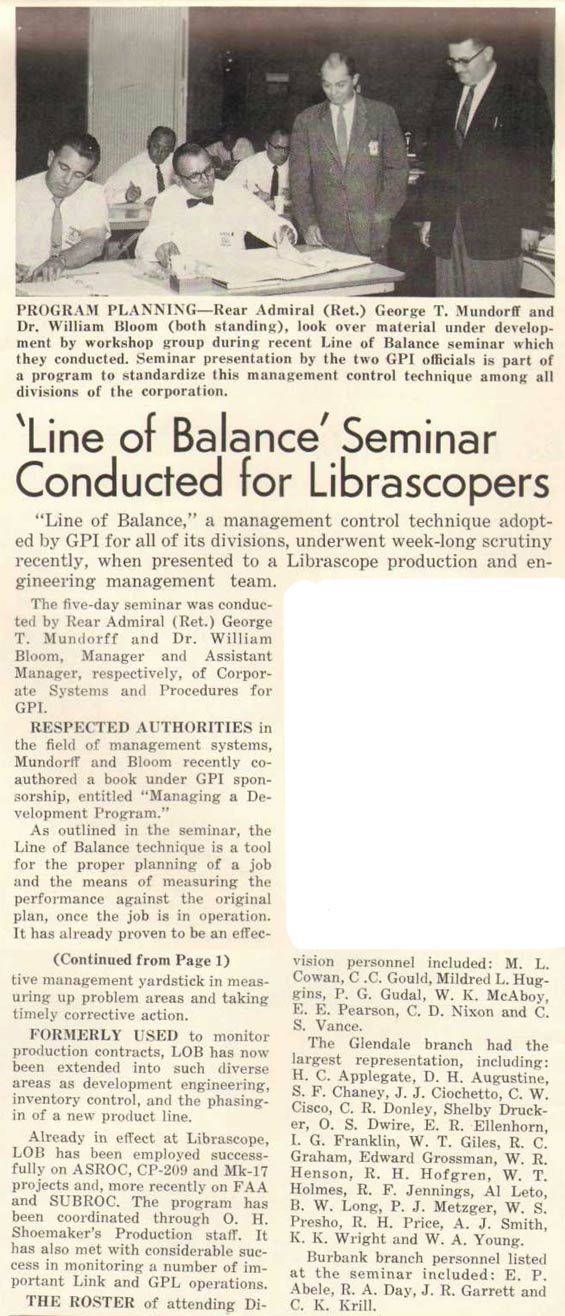 |
Mundorff and William Bloom, the other standing gentleman in the article above, had published a book on management methods in 1960. The bibliographic entry for their book appears in NASA SP-7500(02), "Management: A Continuing Literature Survey With Indexes," published May, 1968. The NASA survey provided a selection of annotated references to unclassified reports and journal articles entering the NASA Information System from 1962 through 1967.
N67-82721 General Precision Inc Little Falls N J
MANAGING A DEVELOPMENT PROGRAM
George T Mundorff and William Bloom 1960 177 p refs
Prepared for Bur of Res and Develop FAA
A guide prepared for Federal Aviation Agency personnel especially those concerned with the conduct and direction of major development programs was designed as a reference text for persons interested in the development of analytical and orderly management programs Details are included for the specific methodologies used to test and evaluate a data processing central
facility and for the line of balance technique used during this evaluation Following details on the evolution and application of this technique organizing for optimum effect is discussed Collec
tion and display of information gathering the facts to establish feasibility and practicability the mechanics of preparation and flow diagrams and the appraisal and presentation of the analysis
are described Details are included for the program as used at the data processing facility including manpower requirements costs and management of the program.
|
Magnetic Core Memory, Ca. 1960s (Source: Web)
 |
An article in The New York TImes (Hong Kong Moving to Forefront of Electronics Industry) of November 25, 1966 described Mundorff's role in the Ampex-Ferrotec company in Hong Kong. Technicians in Hong Kong, by hand, assembled the tiny ferrous rings on cross wires to form what was then termed "core memory" for computers. If you are not of a "certain age," a small piece of core memory is shown in the image at right. Each ferrite core, or donut, was wired with X, Y, sense and inhibit wires. The size of this piece would be a few centimeters square.
A full sheet of core memory could code about 4,000 bits. Multiple, additive sheets were housed in an enclosure. In the day, one could stand beside the memory enclosure of a large computer and hear the donuts "sing" as they were activated and deactivated during computations. Today you can open a checking account at any bank and get a free hand calculator that has more memory and computing power than many, many sheets of core.
Besides the issues of cheap labor and employee burnout (eyestrain), the Times article is a textbook illustration of the pros and cons of outsourcing jobs in the electronics industries. Some of the same general issues prevail today among Pacific Rim suppliers of consumer goods from computers to gym shoes.
Another article in The New York TImes from January 18, 1960 (Ex-Officers in Defense Jobs Listed by House Group) tabulated the salaries of flag and general officers who had left the military and entered private industry with the 100 largest defense contractors. A House sub-committee, led by Rep. F. Edward Hebert, Democrat of Louisiana, inquired into the business activities of officers leaving the Defense Department. The article did not list a reason for the inquiry; just tabulated the results. Mundorff was paid $15,000 per year by GDI, a sizeable salary in 1960. The salaries ranged from $75 per day to $100,000 per year, with $10-20,000 per year being the average. Other Register pilots, Ira C. Eaker for example, earned $33,000 per year from Douglas Aircraft, F.M. Trapnell $13,000 from Grumman, H.L. George $50,000 from Thompson Ramo Wooldridge and E.C. Whitehead earned $13,000 with Northrop. L.E. Gehres' salary with Ryan Aeronautical was "not listed."
Later in his life, an undated article in the Santa Fe New Mexican announced that Mundorff donated his professional library to the College of Santa Fe's Fogelson Library Center. His work with Bloom was probably among those books donated.
G.T. Mundorff Donating His Professional Library, Date Unknown (Source: Woodling)
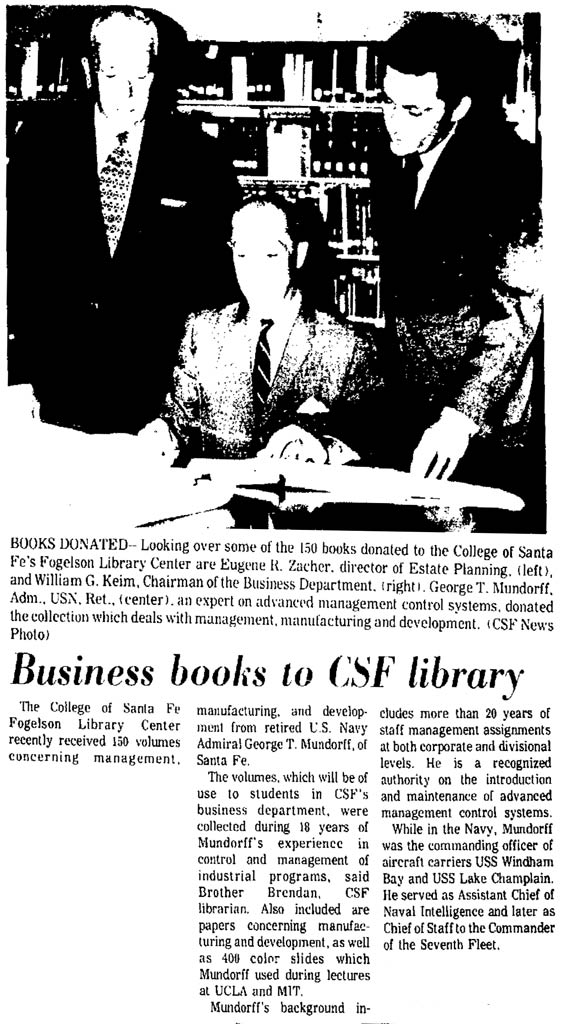 |
An unclassified oral history by Mundorff is available online as a transcript, recorded September 6, 1943. He died March 31, 1978, at the age of 73.
---o0o---
THIS PAGE UPLOADED: 02/08/12 REVISED: 02/20/12
|












